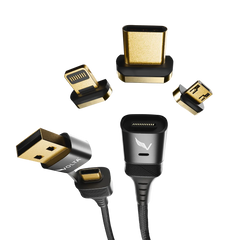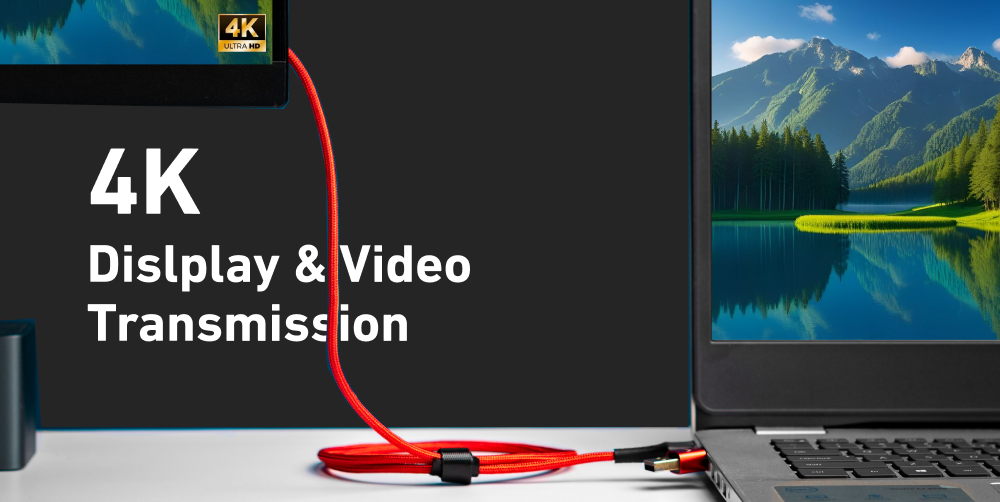The leap from 1080p to 4k isn't just about having a sharper screen, it's about getting the most out of our display. As a gamer, content creator, or everyday user, a proper 4k setup ensures higher refresh rates, richer colors, and smoother performance.
but here's the catch: not all cables are built for true 4k output.
A common frustration is realizing that a cheap or outdated cable is holding back your display. You plug in your 4k monitor, TV, or laptop, expecting crisp visuals, only to get:
- Choppy refresh rates (30Hz instead of 60Hz or 120Hz)
- Color issues (washed-out HDR or incorrect color depth)
- No signal at all (your display might not even recognize the connection)
So, how do you avoid these problems and pick the right cable for 4k? Let's break it down.
What Makes a Cable 4K-Ready?
A 4k display cable isn't just about resolution, it must support:
- 3840 x 2160 resolution (Ultra HD clarity)
- High bandwidth (to avoid flickering or lag)
- Refresh rates of at least 60 Hz (120Hz+ for gaming)
- HDR & color accuracy (for richer visuals)
But there's another problem: port compatibility.
Not all laptops, monitors, and gaming consoles use the same ports, which is why having a versatile cable that adapts to different setups is a game-changer
This is where a universal 4k-compatible cable, like the Volta Max Cable, offers an advantage. Instead of needing multiple cables for different devices, it features magnetic interchangeable tips for USB-C, Lightning, and Micro-USB. Letting you connect multiple displays and gadgets without hassle.

Volta MAX - 240W USB-C Magnetic Charging Cable
$50.00 $0.00
✅ Easy Magnetic Connection ✅ Snap to Charge Your Phone, Laptop, and More ✅ Charges ALL Apple Lightning, USB-C & Micro USB Devices ✅ Supports ...
Best Cables for 4K Displays
Here is a breakdown of the best options and which one suits your setup.
1. HDMI Cables (Best for TVs & Consoles)
Most TVs, gaming consoles, and streaming devices rely on HDMI for 4k output. However, not all HDMI versions are equal:
- HDMI 1.4 → 4k at 30Hz (Not ideal for gaming)
- HDMI 2.0 → 4k at 60Hz (Smooth performance for movies/gaming)
- HDMI 2.1 → 4k at 120Hz+ (Best for PS5, Xbox series X, and high-end PCs)
If you're gaming or watching high-speed action, HDMI 2.1 is the best choice.
2. DisplayPort (Best for PC Monitors & Multi-Displays)
DisplayPort is the top choice for gaming monitors and professional displays, offering:
- DisplayPort 1.2 → 4k at 60Hz
- DisplayPort 1.4 → 4k at 120Hz + HDR
- DisplayPort 2.0 → Even higher refresh rates (Still rare in consumer devices)
For high-refresh-rate gaming monitors, DisplayPort is better than HDMI.
3. USB-C / Thunderbolt (Best for Laptops & Tablets)
Many modern laptops, tablets, and MacBooks use USB-C or Thunderbolt for 4k output:
- USB-C (with DisplayPort Alt Mode) → 4k at 60Hz
- Thunderbolt 3/4 → 4k at 120Hz + (Plus fast data transfer & charging)
If you're using a MacBook, iPad, or a thing laptop, USB-C/Thunderbolt is the best choice.
But here's a common frustration: USB-C cables are fragile and easily wear out, especially at the ports.
This is why the Volta Max Cable stands out. It uses a magnetic connection to reduce wear and tear while ensuring high=speed 4k data transmission. No more frayed cables or damaged ports.
4K Display Setup Tips
Even with the right cable, you might not be getting true 4k performance. Try these fixes
Use a Certified Cable: Cheap cables often lie about their specs, Always check for certification.
Check Your Device's Ports: If your monitor only has HDMI2.0, using an HDMI 2.1 cable won't make a difference
Enable 4k in Display Settings: Many devices default to 1080p. Manually set 3840 x 2160 resolution.
Use a Cable That Does More: If you're switching between a laptop, gaming console, and TV, a multi-port cable like Volta Max saves you the trouble of constantly swapping cables.
Why a Magnetic Cable for 4K?
Most USB-C or HDMI cables work fine, but over time, they break down. Especially at the connection points. If you frequently switch devices, a magnetic cable helps:
- Prevents cable fraying (no wear & tear at the port)
- Quickly swaps between multiple devices (USB-C, lightning, Micro-USB)
- Supports 4k& high-speed data transfer
A perfect example is the Volta Max Cable.

Unlike standard cables, it's built with:
- 20Gbps data speeds for 4k at 60Hz
- Magnetic tips to prevent damage from frequent plugging/unplugging
- Universal compatibility (Works with MacBooks, gaming consoles, tablets, and more)
It's an easy solution for anyone who wants a long-lasting, multi-device 4k cable without constantly replacing damaged connectors.
FAQ: 4K Display & Cables
1. Do all HDMI cables support 4K?
No. Only HDMI 2.0 and higher support 4k at 60Hz or better. Older HDMI 1.4 cables only support 4k at 30Hz, which is laggy for gaming and fast motion.
2. Can I use USB-C for 4K display?
Yes, but your USB-C cable must support DisplayPort Alt Mode, Not all USB-C cables are designed for video output.
3. Why is my 4K monitor stuck at 1080p?
Your system might be:
- Using an incorrect display setting (Check your OS display settings).
- Limited by an outdated cable (Older HDMI/USB-C versions won't support 4k).
- Using a port that doesn't support 4k (some laptop HDMI ports max out at 1080p)
4. Does the cable length affect 4K quality?
Yes. Longer cables (10ft+) can cause signal degradation unless they are high-quality, shielded cables.
5. What’s the best cable for gaming at 4K 120Hz?
For PC gaming, go for DisplayPort 1.4 or HDMI 2.1. For consoles like PS5 & Xbox Series X, HDMI 2.1 is a must.



Leave a comment
This site is protected by hCaptcha and the hCaptcha Privacy Policy and Terms of Service apply.